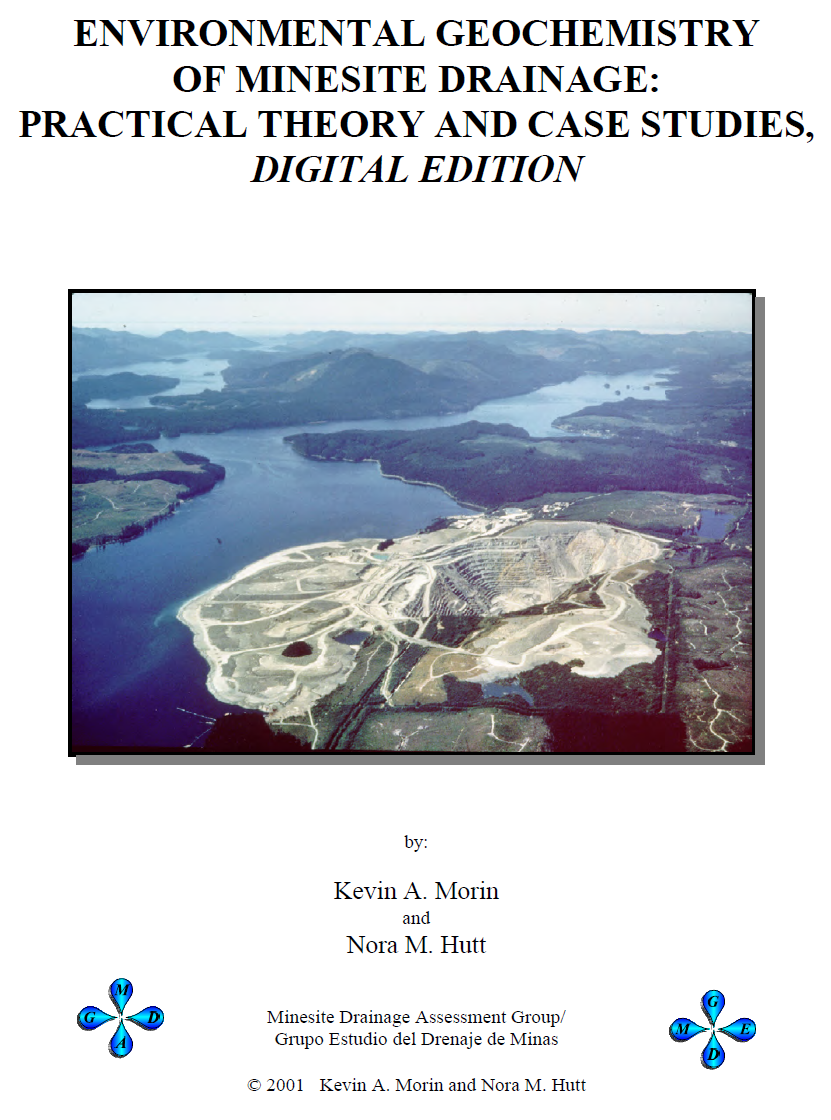
Home ⋅ Book: An Introduction ⋅ Book: Spectral Analysis ⋅ Book: EFA ⋅ Book: Wavelets ⋅ MDAG Papers ⋅ MDAG IKD Database ⋅ MDAG Grain 3.0 ⋅ Minewall 3

- Available in PDF for immediate free download.
~7 MB in size. ISBN 0-9682039-1-4
This book is free.
Please click on "Get access code", enter the case-sensitive code, click on "Validate code",
and you will be redirected to the book in PDF format.
- Available in a hard-cover paper version.
A few copies remaining in stock - starting at CAD$60.00 (plus 5% GST in Canada plus shipping
and handling). ISBN 0-9682039-0-6.
Send inquires to: contact@mdag.com
Abbreviated Table of Contents (below)
Errata and Clarifications Since Release
Biographies of the Authors (Kevin Morin and Nora Hutt) and Other MDAG Members
Other publications by MDAG staff
The study of drainage chemistry at mines and mining operations is expanding rapidly, particularly for acidic drainage. Although there have been many conferences and symposia on minesite drainage, there has been no book that compiles and interprets the relevant theory and international case studies. To fill this need, Kevin Morin and Nora Hutt have written more than 350 pages based on nearly 360 references and 92 supporting international case studies. All types of drainage are examined, from acidic to alkaline drainage, and brine-like drainage from evaporite mining. Acidic drainage is emphasized because of the overwhelming number of papers and reports on it.
The practical theory and case studies are highlighted with 68 tables and 145 figures, discussing drainage chemistry from open pits, underground workings, waste-rock dumps, ore stockpiles, and tailings impoundments. Appendices include a glossary and internationally accepted methods for predictive tests. There are indexes for subjects, minesites, case studies, and authors.
Environmental Geochemistry of Minesite Drainage: Practical Theory and Case Studies is designed to serve three purposes. First, it is a guidebook for assessing, predicting, and controlling minesite-drainage chemistry. Second, it is a reference book illustrating the current level of knowledge and directing the reader toward valuable references for further details. Third, it is a textbook for students learning drainage chemistry, with questions at the end of each chapter to highlight important issues and to provoke further thought. The book therefore offers many benefits for beginners to experts in the field of minesite-drainage chemistry.
Environmental Geochemistry of Minesite Drainage: Practical Theory and Case Studies
(1997; ISBN 0-9682039-0-6).
The paper copy of the book has a hard cover and sewn binding, with pages nominally
measuring 8.5 by 11 inches in size. An Abbreviated Table of Contents is listed below.
Environmental Geochemistry of Minesite Drainage: Practical Theory and Case Studies
(2001; ISBN 0-9682039-1-4). *IMPORTANT NOTE: Because of changes in fonts and graphics when converted to PDF, some columns of text
are shorter and thus end before the bottom of the page - this is not an
error and there is no text missing. Also, some pages may not print
properly to paper, because the PDF file is optimized for screen viewing. An Abbreviated Table of Contents is listed below.
Home
⋅
Book: An Introduction
⋅
Book: Spectral Analysis
⋅
Book: EFA
⋅
Book: Wavelets
⋅
MDAG Papers
⋅
MDAG IKD Database
⋅
MDAG Grain 3.0
⋅
Minewall 3
Created by K.Morin
The digital PDF version is approximately 13
MB in size, and available by Internet download.
Features:
1. INTRODUCTION
2. LAYOUT OF MINESITES AND THEIR COMPONENTS
2.1 Overview and Terminology
2.2 The Mine Component
2.3 Ore Stockpiles, Low-Grade-Ore Stockpiles, and Waste-Rock Dumps
2.4 Dams, Roads, and Building Foundations
2.5 Tailings Impoundments and Mills
2.6 Other Components
2.7 Questions
3. FLOW OF MINESITE DRAINAGE
3.1 Overview
3.2 Drainage Flow through and from Mines
3.3 Drainage Flow from Stockpiles, Dumps, and Mined-Rock Piles
3.4 Drainage Flow from Tailings Impoundments
3.5 Questions
4. DESCRIPTION AND ASSESSMENT OF DRAINAGE CHEMISTRY
4.1 Overview
4.2 General Description
4.2.1 Kinetic and Equilibrium Reactions
4.2.2 Three Stages of Drainage Chemistry
4.2.3 Four Classes of Drainage Chemistry
4.2.4 Bacterial Contributions to Drainage Chemistry
4.2.5 General Trends in Minesite-Drainage Chemistry
4.2.6 Relationship of Drainage Chemistry to Flow
4.3 Drainage Chemistry from Mines
4.4 Drainage Chemistry from Stockpiles, Dumps, and Mine-Rock Piles
4.5 Drainage Chemistry from Tailings Impoundments
4.6 Questions
5. PREDICTION OF DRAINAGE CHEMISTRY
5.1 Overview
5.2 Static Tests
5.2.1 Acid-Base Accounting (ABA)
5.2.2 Mineralogy
5.2.3 Total-Metal and Whole-Rock Analysis
5.2.4 Retention of Reaction Products
5.2.5 Grain-Size Analysis and Particle-Surface Area
5.2.6 Other Static Tests
5.3 Laboratory-Based Kinetic Tests
5.3.1 Humidity Cells
5.3.2 Columns
5.3.3 International Kinetic Database
5.4 Field Kinetic Tests
5.4.1 Bins or Cribs
5.4.2 Minewall Stations
5.4.3 Routine Site Monitoring
5.5 Adjustments of Static and Kinetic Tests for Full-Scale Minesite
Components
5.5.1 Portions of Components Exposed to Air and Water
5.5.2 Portions of Components Exposed to Water Only
5.6 Questions
6. CONTROL OF DRAINAGE CHEMISTRY
6.1 Reactive Control of Drainage Chemistry
6.1.1 Active Collection and Treatment
6.1.2 Passive Collection and Treatment
6.2 Solid Covers
6.3 Water Covers
6.4 Other Techniques
6.5 Questions
REFERENCES
INDEXES
A. GLOSSARY
B. METHODS FOR STATIC TESTS
C. METHODS FOR KINETIC TESTS
D. METHODS FOR MINEWALL STATIONS